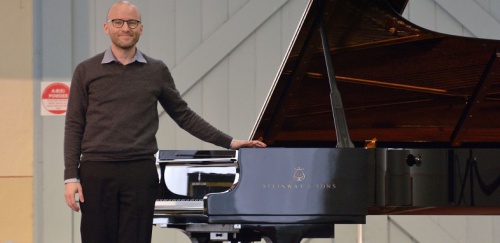
As was the case in the first two concerts, it was interesting to hear the development in Beethoven’s compositional style and also to hear the different interpretations given to his music by the pianists.
Across these three concerts there were some stand-outs from both ends of the enjoyment spectrum. Most though gave fine and thoroughly entertaining performances.
Anna Goldsworthy appeared in two of the concerts, opening the first with Op 13 (1798). Beethoven was 27 years old. This work, nicknamed “Pathétique” is probably Beethoven’s most celebrated piano sonata (the “Moonlight” is probably the most-loved).
Goldsworthy played it with great passion, opening it in an almost defiant mood. Throughout she created drama, suspense and emotion in something of a symphonic style using considerable dynamics and much sensitivity as her palette. At times, though, in the loud passages, Goldsworthy was a little bombastic in her approach.
Her other work Op 90, written 16 years later, also was afforded a sensitive treatment, but once again suffering a little from heavy-handedness in some of the loud passages.
Another artist also suffered from heavy-handedness. Established Beethoven specialist and much lauded and awarded Maria Mazo played Op 57 (1805), known as the “Appassionata”. Her flawless technique easily carried her through this very demanding work, which she played at a frenetic tempo. She clearly was deeply impassioned in her creation of a huge dynamic range. But at the loud end of that range it was way too much. The nine-foot Steinway concert grand struggled to make something of the strongly forced chords, losing clarity of tone and definition of the notes, compounded by overuse of the sustain pedal. Still, the audience liked it, many leaping to their feet at the end. Perhaps it was the showiness of Mazo’s playing. For me, my head was hurting and my ears were ringing.
Arnan Wiesel also made an appearance in two concerts, playing the Op 28 (1801) “Pastoral” and Op 14 No 2 (1799). In the first Wiesel was a little tentative at the start, but quickly settled in to play with confidence in a delightful performance of considerable sensitivity. I especially liked his playful treatment of the 3rd movement, Scherzo. His beautiful playing continued into the second work, with the piano singing, especially in the descending thirds. His expressive, lyrical playing created a great sense of sweetness throughout this charming work.
Both Nicholas Matthew, playing Op 79 (1809), and Gil Garburg, playing Op 110 (1821), presented beautiful performances in their second appearances at the Festival. Matthew has a lovely gentle and expressive touch, which gives him a very lyrical style. Garburg displayed with brilliant technique and superb control of the dynamics.
Also making their second appearances were Gabi Sultana, playing Op 10 No 1 (1798), and Kotaro Nagano, playing Op 22 (1800). Both showed excellent technique being in full control of the dynamics ranging from the lyrical to the “in-your-face” elements. Sultana showed a sensitive personal connection to her piece, but Nagano’s technical brilliance was not so well supported by his interpretation of the work he played.
Showing that some maturity and experience gives an edge, Ian Munro, playing Op 31 No 1 (1802), and Clemens Leske, playing Op 26 (1801) both gave insightful, well-controlled performances. Munro’s trills and runs especially were nothing short of virtuosic. Leske gave a beautifully balanced performance with superb technique and a lovely touch to boot. He especially showed just how crescendos and diminuendos should be played; what superb control he had, adding a whole new dimension to the dynamics of the piece.
Across these three concerts there were three stand-out performances.
A Festival favourite, Daniel de Borah, gave a masterly, brilliant and captivating performance of Op 101 (1816). His fluid style, his amazing attention to detail, his outstanding sensitivity and, of course, his virtuosity are what make de Borah so popular on the international stage. What a treasure he is!
Stephanie McCallum, playing Op 10 No 2 (1798) showed consummate technique, dynamic control and a reading that fitted the piece perfectly to its time in the early part of Beethoven’s compositional career, influenced as it was by Mozart and Haydn.
Concluding the last of the three concerts was Sivan Silver, playing Op 109 (1820). Silver was able to step right into this quite introspective work, creating a sensitivity of playing that no other artist had achieved in this series so far. Even when her young son approached the stage during the first movement she remained focused on achieving the emotion of the piece, pausing in the break to reassure him and then continuing utterly unfazed, much to the audience’s delight! At the end of the 3-movement work, she received a well-deserved standing ovation.
So, two concerts and seven sonatas remain to be performed on May 3, including that much-loved “Moonlight”. It will complete an outstanding cycle in this 21st Canberra International Music Festival.
Who can be trusted?
In a world of spin and confusion, there’s never been a more important time to support independent journalism in Canberra.
If you trust our work online and want to enforce the power of independent voices, I invite you to make a small contribution.
Every dollar of support is invested back into our journalism to help keep citynews.com.au strong and free.
Thank you,
Ian Meikle, editor








Leave a Reply